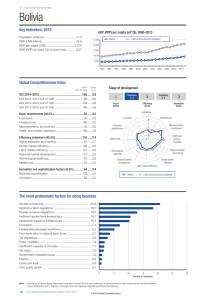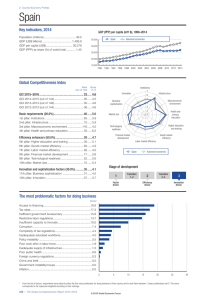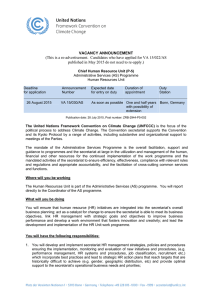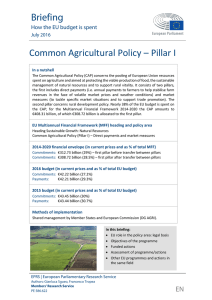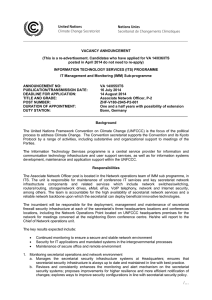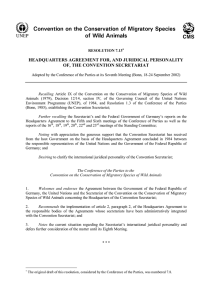the peripheral maritime regions and the future of the cap
Anuncio
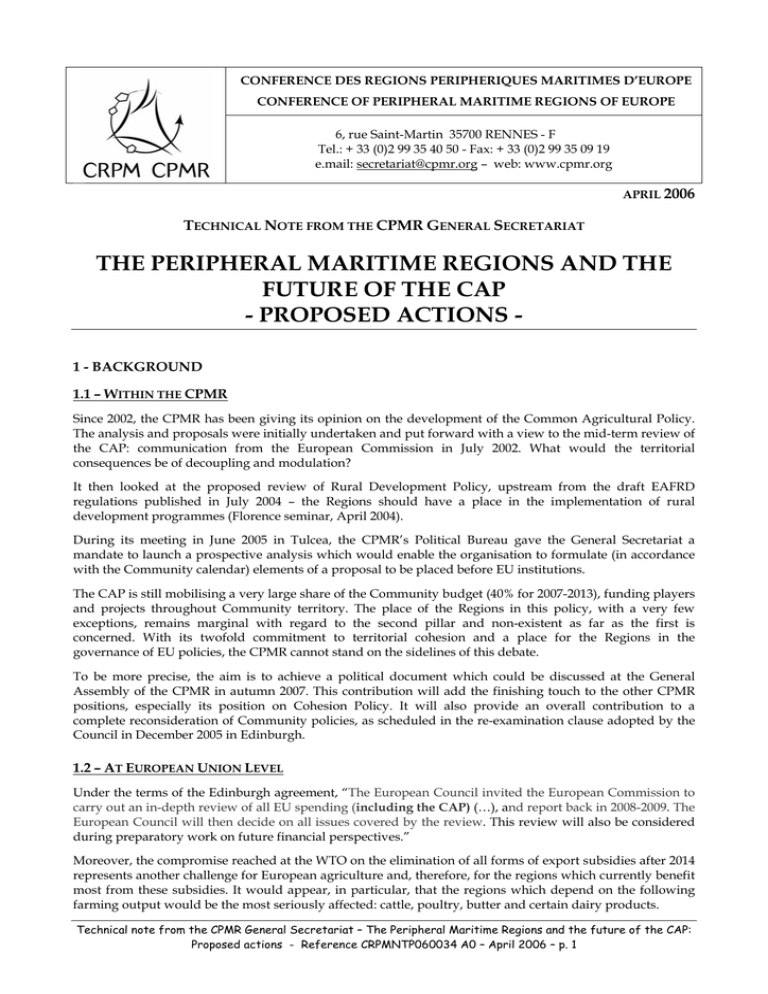
CONFERENCE DES REGIONS PERIPHERIQUES MARITIMES D’EUROPE CONFERENCE OF PERIPHERAL MARITIME REGIONS OF EUROPE 6, rue Saint-Martin 35700 RENNES - F Tel.: + 33 (0)2 99 35 40 50 - Fax: + 33 (0)2 99 35 09 19 e.mail: [email protected] – web: www.cpmr.org CRPMNTP060034 A0 APRIL 2006 TECHNICAL NOTE FROM THE CPMR GENERAL SECRETARIAT THE PERIPHERAL MARITIME REGIONS AND THE FUTURE OF THE CAP - PROPOSED ACTIONS 1 - BACKGROUND 1.1 – WITHIN THE CPMR Since 2002, the CPMR has been giving its opinion on the development of the Common Agricultural Policy. The analysis and proposals were initially undertaken and put forward with a view to the mid-term review of the CAP: communication from the European Commission in July 2002. What would the territorial consequences be of decoupling and modulation? It then looked at the proposed review of Rural Development Policy, upstream from the draft EAFRD regulations published in July 2004 – the Regions should have a place in the implementation of rural development programmes (Florence seminar, April 2004). During its meeting in June 2005 in Tulcea, the CPMR’s Political Bureau gave the General Secretariat a mandate to launch a prospective analysis which would enable the organisation to formulate (in accordance with the Community calendar) elements of a proposal to be placed before EU institutions. The CAP is still mobilising a very large share of the Community budget (40% for 2007-2013), funding players and projects throughout Community territory. The place of the Regions in this policy, with a very few exceptions, remains marginal with regard to the second pillar and non-existent as far as the first is concerned. With its twofold commitment to territorial cohesion and a place for the Regions in the governance of EU policies, the CPMR cannot stand on the sidelines of this debate. To be more precise, the aim is to achieve a political document which could be discussed at the General Assembly of the CPMR in autumn 2007. This contribution will add the finishing touch to the other CPMR positions, especially its position on Cohesion Policy. It will also provide an overall contribution to a complete reconsideration of Community policies, as scheduled in the re-examination clause adopted by the Council in December 2005 in Edinburgh. 1.2 – AT EUROPEAN UNION LEVEL Under the terms of the Edinburgh agreement, “The European Council invited the European Commission to carry out an in-depth review of all EU spending (including the CAP) (…), and report back in 2008-2009. The European Council will then decide on all issues covered by the review. This review will also be considered during preparatory work on future financial perspectives.” Moreover, the compromise reached at the WTO on the elimination of all forms of export subsidies after 2014 represents another challenge for European agriculture and, therefore, for the regions which currently benefit most from these subsidies. It would appear, in particular, that the regions which depend on the following farming output would be the most seriously affected: cattle, poultry, butter and certain dairy products. Technical note from the CPMR General Secretariat – The Peripheral Maritime Regions and the future of the CAP: Proposed actions - Reference CRPMNTP060034 A0 – April 2006 – p. 1 Changes in the first pillar Given the inviolability of the first pillar until the end of 2013, it seems fairly unlikely that the system of direct, decoupled aids will undergo any major modifications in the short term. In any case, a decision on such changes could only be based on assessments of the effects of the mid-term review. Since the review was only undertaken in 2004 in the first countries to apply it, it is as yet too close for the European Commission to be able to suggest any changes. It should, however, be remembered that the Edinburgh agreement gives Member States the possibility of moving onto the second pillar amounts equal to a maximum of 20% of the credits allocated as direct, decoupled aid. This is optional, and additional to the 5% mandatory modulation. The interest it arouses among Member States should be monitored but it can be described as the first waiver to the “dogma” of inviolability. From a much more fundamental point of view, the post-2013 period is crucial for the future of the first pillar: - Application of the WTO agreement; - End of inviolability; - Uncertainties with regard to changes in European public opinion, and the acceptance of a CAP which may initially appear to be devouring large amounts of the budget while paying little attention to environmental issues; - New conditions for discussion in the Council: new Member States with less highly-developed agriculture, changes in the Franco-German relationship, arrival of new executives in the Member States that are the most ardent supporters of the first pillar; - Possible changeover to co-decision making, as requested by certain Members of the European Parliament within the framework of a possible future Treaty. Given this situation, radical modifications may well be made to the first pillar after 2013. Quite apart from the farming population, this is an issue for regional economies, for the processing sector and for employment in rural areas. It also poses a challenge if the landscape is to remain unchanged. The Regions must therefore be able to plan for these changes, prepare for them and bring pressure to bear on Community decisions as early in the process as possible to change policies or influence possible programmes to assist with future changes. To do this, they must be in possession of information that sheds light on the issues. Such information does not appear to exist at the present time and the CPMR wishes to help to make it available. Place of the Regions in the Implementation of the Second Pillar Rural development is one of the items that suffered most from the budgetary discussions and decisions of late 2005. It is also a policy whose implementation remains in the hands of the States and, by virtue of subsidiarity, the States can then decide whether or not to hand on all or some of its implementation to the Regions. Using the Community Strategic Guidelines adopted by the Council, Member States are currently preparing their national guidelines and defining their priorities within the fairly unrestrictive choice of measures eligible under the new EAFRD regulations. The benchmarking seminar that the CPMR is organising on 31st May next will provide a high-quality photograph of the partnership between State and Region when drafting programmes. Although there is, unfortunately, nothing more that can be done for the 2007-2013 period, limiting the CPMR’s role to the mere monitoring of implementation, there is an urgent need to consider the restrictive conditions of regional involvement for the future period. Given the increasing importance of territory in the CAP, it is logical for formal EU / State / Region partnerships to have priority. It is happening at the present time with the implementation of cohesion policy. Technical note from the CPMR General Secretariat – The Peripheral Maritime Regions and the future of the CAP: Proposed actions - Reference CRPMNTP060034 A0 – April 2006 – p. 2 2- PROPOSED TIMETABLE FOR THE CPMR 2.1 – THE KEY DATES ARE AS FOLLOWS: - 5th May 2006, CPMR’s Political Bureau meeting on Gozo: adoption of a programme of work; - October 2006, CPMR General Assembly in Murcia: presentation of an initial framework report on the Regions in the CPMR and the CAP. This report will highlight the characteristics of the Regions in the CPMR and the extent to which they affect their dependence on first pillar funding. It will include a regional typology test and a simulation of the likely impact of various possible scenarios for change after 2013. As far as possible, this work will not be limited to the agricultural economy in its strictest sense but will show the issues for food-processing industries and rural employment; - Autumn 2007, General Assembly of the CPMR: adoption of a political position with a view to taking part in the debate prior to the mid-term review of EU policies. The position will cover both the first and second pillars. Other dates will be added to this as yet brief timetable. Too few details are yet available with regard to the timetable and conditions of the mid-term review but there is an obvious need for on-going involvement, at least through 2008. 2.2 – THE PROGRAMME FOR THE NEXT FEW MONTHS A Series of Targeted Contacts The General Secretariat of the CPMR has been in contact with various bodies and agencies since the beginning of 2006 with a view to obtaining a clearer idea of the “landscape” in which reforms will be prepared: - Meetings in the office of Madam Commissioner Fischer Boel and at the DG – Agriculture at the European Commission; - Meeting with CIHEAM, (International Centre for Advanced Mediterranean Agronomic Studies); - Meeting with the French Ministry of Agriculture, which drafted the recent “Memorandum of the Twelve” presented on 20th March 2006 at the EU’s Agricultural Council. These contacts will continue during the next few weeks. Identifying and Using Relevant Studies and Think Tanks Although the future of the CAP, especially its territorial aspects, seems to be a major issue, very few studies, reports or considerations from think tanks have yet risen to the surface during public debate. Research will be undertaken to try and collate the available material on this topic. ESPON’s work is something of an exception and its results should be used. Regional Typology Based on Dependence on the First Pillar With the assistance of its Forward Studies Unit, the CPMR will draw up a typology proposal based on available sources of statistical data. For all these aspects (contacts, studies, think tanks and statistical data), all information and assistance from the Regions will be gratefully received. Technical note from the CPMR General Secretariat – The Peripheral Maritime Regions and the future of the CAP: Proposed actions - Reference CRPMNTP060034 A0 – April 2006 – p. 3
